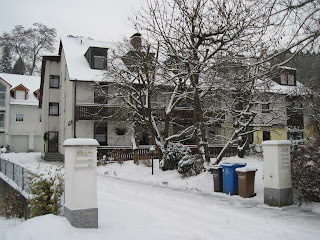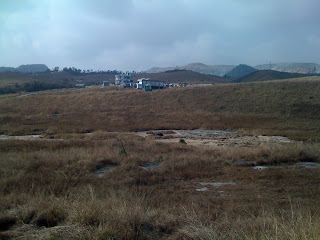I continued to work on the sites and monuments of Jerusalem project. Hanswulf came from Tübingen on Monday and Tuesday January 18 and 19 to discuss progress.
I also had further class periods of my History and Archaeology of Bilad al-Sham from Justinian to Harun al-Rashid. One of the students had a scheduling conflict for the scheduled class time on Fridays, so on Saturday January 9, we had three class periods one after the other as a block seminar.
I also started work on a new article for the upcoming festschrift of Fred Donner, my PhD supervisor at the University of Chicago.
The weather was cold and snowy. The temperatures rose above freezing for only a couple of days the entire month. The snow on the ground was no obstacle for some bicyclists.



Most weekends I stayed in Bamberg. The one trip I made was to attend a conference in Berlin on Islamic art museums. On Wednesday January 13 I traveled to Berlin by train with Ilse and Anja, and another student, arriving in time for the opening lecture in the Mshatta Hall of the Pergamon Museum by Oleg Grabar, followed by a reception. On Thursday January 14 I attended the conference sessions in the Pergamon Museum and during the lunch break I toured the museum, taking some photographs of the famous façade from the Umayyad period palace of Mshatta in Jordan.

On Friday January 15 I attended the morning session of the conference and then in the afternoon went to the newly re-opened Neues Museum, which houses the Egyptology collection. The conference was held as part of the process of planning for the new design of the Islamic Art collection and the rest of the Pergamon Museum. The renovation of the building has gotten underway, in the latest phase of the decades-long renovations of the various museums in Berlin’s Museum Island.

The Pergamon Museum under renovation
I then went to the train station in time for a 4:20 departure back to Bamberg. Unfortunately, the unusually cold weather had been causing problems with the train service. My train was delayed and after making some alternative connections, I finally got to Leipzig at 7:45. By then it was too late to catch the last regional train to Bamberg of the day with my cheap ticket, so I had to take an expensive intercity express, which itself left an hour and a half late. So I finally got back to my apartment at 1:15 am.
Among other complications, on the evening of Tuesday January 26 the transformer unit on the power cord of my lap-top computer shorted out. That blew the fuse in my apartment, leaving half of my apartment without power until the next day. I could not find a replacement cord anywhere in Bamberg, so I had to order it over the internet, which took a few days to arrive. I was able to use my desk-top Apple computer, however.
Over the past months I have had wireless internet access in my apartment using a wireless account of some neighbor that was not password protected. On January 28 I called up Zovi in Shillong on her birthday using Skype over that connection. But on Friday January 29 that neighbor put a password on the account, which meant that I no longer had internet access at home. That was not a major problem, because I can use the wireless internet at the university and in fact it was sometime of a blessing in disguise, since I have tended to waste too much time browsing the internet in my apartment.
Among other things, I also bought a new digital camera; my old camera had malfunctioned at the start of my India trip, so I had to use the lower quality camera on my iPhone for my India photographs. My French class on Tuesday evenings continued. I also went to see the movie Avatar in 3-D and on Sunday January 24 I attended an Irish step dance session for a last time on this stay in Bamberg. When Hanswulf came, he brought the German comedian Loriot to my attention; his humorous segments from decades past can be found on Youtube.


 Timothy and Shanely performing
Timothy and Shanely performing Diane D’Souza giving her presentation
Diane D’Souza giving her presentation
 New Years greetings on a street in Vijayawada
New Years greetings on a street in Vijayawada The Undavalli caves
The Undavalli caves The Buddha carving in the interior
The Buddha carving in the interior
 The stupa at Amaravathi
The stupa at Amaravathi The cups lining the stupa
The cups lining the stupa Fishermen along the coast
Fishermen along the coast Rani Sarma at one of the early Buddhist stupas at Bheemunipatnam, with the Dutch residence in the background.
Rani Sarma at one of the early Buddhist stupas at Bheemunipatnam, with the Dutch residence in the background.  Rani with a Buddhist sculpture
Rani with a Buddhist sculpture Sony at the entrance to her hostel building
Sony at the entrance to her hostel building The orphans
The orphans The line up for the community dinner
The line up for the community dinner  Zovi on the left and Sony on the right with me at the community dinner
Zovi on the left and Sony on the right with me at the community dinner
 The back side of Zovi’s place
The back side of Zovi’s place Zovi and Sony cooking the exploding chili peppers
Zovi and Sony cooking the exploding chili peppers The Butterfly Museum
The Butterfly Museum

 Rev. Lalramliana Pachuau and his wife Marovi. Note the charcoal heater at their feet
Rev. Lalramliana Pachuau and his wife Marovi. Note the charcoal heater at their feet  Mawlynnong village with the waste baskets
Mawlynnong village with the waste baskets The bamboo lookout tower with some trash behind the rock
The bamboo lookout tower with some trash behind the rock Me with Bangladesh in the background
Me with Bangladesh in the background
 The picnic lunch
The picnic lunch 
 The Living Root Bridge
The Living Root Bridge The Living Root Bridge
The Living Root Bridge
 The Nohkalikai Falls
The Nohkalikai Falls The landscape around the Nohkalikai Falls
The landscape around the Nohkalikai Falls
 The group in the Mawsmai Cave
The group in the Mawsmai Cave

 The Mawsmai Eco-Park
The Mawsmai Eco-Park The Mawsmai Eco-Park with some ancient monoliths
The Mawsmai Eco-Park with some ancient monoliths  The Mawsmai Eco-Park Bridge
The Mawsmai Eco-Park Bridge The Elephant Falls
The Elephant Falls Zohmangahi Rokhum aka Zovi or Zohmai
Zohmangahi Rokhum aka Zovi or Zohmai  The Presbyterian Church of India building where she lives
The Presbyterian Church of India building where she lives A photo from April 2006 in Aizawl, Mizoram. Zovi is in the yellow dress on the far right and Terini is in the red blouse on the left.
A photo from April 2006 in Aizawl, Mizoram. Zovi is in the yellow dress on the far right and Terini is in the red blouse on the left.